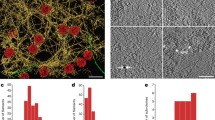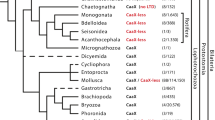Abstract
Previous analyses of the nuclear lamina of mammalian cells have revealed three major protein components (lamins A, B and C) that have been identified by protein sequence homology as members of the intermediate filament (IF) protein family. It has been claimed that mammalian cells contain either all three lamins or lamin B alone. Using monoclonal antibodies specific for B-type lamins and cDNA cloning we identified a second major mammalian B-type lamin (murine lamin B2), thus showing that lamin composition in mammals is more complex than previously thought. Lamin B2 is coexpressed with lamin B1 (formerly termed lamin B) in all somatic cells and mammalian species that we analysed, including a variety of cells currently believed to contain only a single lamin. This suggests that two B-type lamins are necessary to form a functional lamina in mammalian somatic cells. By cDNA cloning we found thatXenopus laevis lamin LII is the amphibian homolog of mammalian lamin B2. Lamin expression during embryogenesis of amphibians and mammals shows striking similarities. The first lamins expressed in the early embryo are the two B-type lamins, while A-type lamins are only detected much later in development. These findings indicate that the genomic differentiation into two B-type lamins occurred early in vertebrate evolution and has been maintained in both their primary structure and pattern of expression.
Similar content being viewed by others
References
Aebi U, Cohn J, Buhle L, Gerace L (1986) The nuclear lamina is a meshwork of intermediate-type filaments. Nature 323:560–564
Beck L, Hosick TJ, Sinensky M (1988) Incorporation of a product of mevalonic acid metabolism into proteins of chinese hamster ovary cell nuclei. J Cell Biol 107:1307–1316
Benavente R, Krohne G (1985) Change of karyoskeleton during spermatogenesis ofXenopus: Expression of lamin LIV, a nuclear lamina protein specific for the male germ line. Proc Natl Acad Sci USA 82:6176–6180
Benavente R, Krohne G (1986) Involvement of nuclear lamins in postmitotic reorganization of chromatin as demonstrated by microinjection of lamin antibodies. J Cell Biol 103:1847–1854
Benavente R, Krohne G, Franke WW (1985) Cell type-specific expression of nuclear lamina proteins during development ofXenopus laevis. Cell 41:177–190
Burke B, Gerace L (1986) A cell free system to study reassembly of the nuclear envelope at the end of mitosis. Cell 44:639–652
Chelsky D, Olson JF, Koshland Jr DE (1987) Cell cycle-dependent methyl esterification of lamin B. J Biol Chem 262:4303–4309
Chelsky D, Sobotka C, O'Neill CL (1989) Lamin B methylation and assembly into the nuclear envelope. J Biol Chem 264:7637–7643
Cowin P, Kapprell H-P, Franke WW, Tamkun J, Hynes RO (1986) Plakoglobin: A protein common to different kinds of intercellular adhering junctions. Cell 46:1063–1073
Doetschman TC, Eistetter H, Katz M, Schmidt W, Kemler R (1985) The in vitro development of blastocyst-derived embryonic stem cell lines: Formation of visceral yolk sac, blood islands and myocardium. J Embryol Exp Morphol 87:27–45
Farnsworth CC, Gelb MH, Glomset JA (1990) Identification of geranylgeranyl-modified proteins in HeLa cells. Science 247:320–322
Feinberg AP, Vogelstein B (1983) A technique for radiolabeling DNA restriction endonuclease fragments to high specific activity. Anal Biochem 132:6–13
Fisher DZ, Chaudhary N, Blobel G (1986) cDNA sequencing of nuclear lamins A and C reveals primary and secondary structural homology to intermediate filaments. Proc Natl Acad Sci USA 83:6450–6454
Franke WW (1987) Nuclear lamins and cytoplasmic intermediate filament proteins: A growing multigene family. Cell 48:3–4
Georgatos SD, Blobel G (1987) Lamin B constitutes an intermediate filament attachment site at the nuclear envelope. J Cell Biol 105:117–125
Gerace L, Blobel G (1980) The nuclear envelope lamina is reversibly depolymerized during mitosis. Cell 19:277–287
Gerace L, Burke B (1988) Functional organization of the nuclear envelope. Annu Rev Cell Biol 4:335–374
Gerace L, Blum A, Blobel G (1978) Immunocytochemical localization of the major polypeptides of the nuclear pore complexlamina fraction. J Cell Biol 79:546–566
Gerace L, Comeau C, Benson M (1984) Organization and modulation of nuclear lamina structure. J Cell Sci [Suppl] 11:137–160
Guilly MN, Bensussan A, Bourge JF, Bornens JC, Courvalin JC (1987) A human T lymphoblastic cell line lacks lamin A and C. EMBO J 6:3795–3799
Hazan R, Denk H, Franke WW, Lackinger E, Schiller DL (1986) Change of cytokeratin organization during development of mallory bodies as revealed by a monoclonal antibody. Lab Invest 54:543–553
Höger TH, Krohne G, Franke WW (1988) Amino acid sequence and molecular characterization of murine lamin B as deduced from cDNA clones. Eur J Cell Biol 47:283–290
Holtz D, Tanaka RA, Hartwig J, McKeon F (1989) The CaaX motif of lamin A functions in conjunction with the nuclear localization signal to target assembly to the nuclear envelope. Cell 59:969–977
Ierardi LA, Moss SB, Bellvé AR (1983) Synaptonemal complexes are integral components of the isolated mouse spermatocyte nuclear matrix. J Cell Biol 96:1717–1726
Jackson BW, Grund C, Schmid E, Bürki K, Franke WW, Ilmensee K (1980) Formation of cytoskeletal elements during mouse embryogenesis. Differentiation 17:161–179
Jahn L, Fouquet B, Rohe K, Franke WW (1987) Cytokeratins in certain endothelial and smooth muscle cells of two taxonomically distant vertebrate species,Xenopus laevis and man. Differentiation 36:234–254
Jorcano JL, Rieger M, Franz JK, Schiller DL, Moll R, Franke WW (1984) Identification of two types of keratin polypeptides within the acidic cytokeratin subfamily I. J Mol Biol 179:257–281
Kartenbeck J, Schwechheimer K, Moll R, Franke WW (1984) Attachment of vimentin filaments to desmosomal plaques in human mengiomal cells and arachnoidal tissue. J Cell Biol 98:1072–1081
Kaufmann S (1989) Additional members of the rat liver lamin polypeptide family. J Biol Chem 264:13946–13955
Kleinschmidt J, Dingwall C, Maier G, Franke WW (1986) Molecular characterization of a karyophilic, histone binding protein: cDNA cloning, amino acid sequence and expression of nuclear protein N1/N2 ofXenopus laevis. EMBO J 5:3547–3552
Krohne G, Benavente R (1986) The nuclear lamins. A multigene family of proteins in evolution and differentiation. Exp Cell Res 162:1–10
Krohne G, Franke WW (1983) Proteins of pore complex-lamina structures from nuclei and nuclear membranes. Methods Enzymol 96:597–608
Krohne G, Dabauvalle MC, Franke WW (1981) Cell type-specific differences in protein composition of nuclear pore complexlamina structures in oocytes and erythrocytes ofXenopus laevis. J Mol Biol 151:121–141
Krohne G, Debus E, Osborn M, Weber K, Franke WW (1984) A monoclonal antibody against nuclear lamina proteins reveals cell type-specificity inXenopus laevis. Exp Cell Res 150:47–59
Krohne G, Wolin SL, McKeon FD, Franke WW, Kirschner MW (1987) Nuclear lamin LI ofXenopus laevis: cDNA cloning, amino acid sequence and binding specificity of a member of the lamin B subfamily. EMBO J 6:3801–3808
Krohne G, Waizenegger I, Höger TH (1989) The conserved carboxy-terminal cysteine of nuclear lamins is essential for lamin association with the nuclear envelope. J Cell Biol 109:2003–2011
Laemmli UK (1970) Cleavage of structural proteins during the assembly of the head of bacteriophage T4. Nature 277:680–685
Lebel S, Lampron C, Royal A, Raymond Y (1987) Lamins A and C appear during retinoic acid-induced differentiation of mouse embryonal carcinoma cells. J Cell Biol 105:1099–1104
Lehner CF, Kurer V, Eppenberger HM, Nigg EA (1986) The nuclear lamin protein family in higher vertebrates. J Biol Chem 261:13293–13301
Lehner CF, Stick R, Eppenberger HM, Nigg EA (1987) Differential expression of nuclear lamin proteins during chicken development. J Cell Biol 105:577–587
Longo F, Krohne G, Franke WW (1987) Basic proteins of the perinuclear theca of mammalian spermatozoa and spermatids: A novel class of cytoskeletal elements. J Cell Biol 105:1105–1120
Maniatis T, Fritsch EF, Sambrook J (1982) Molecular cloning. A laboratory manual. Cold Spring Harbor Laboratory, Cold Spring Harbor, New York
Maxam A, Gilbert W (1980) Sequencing end-labeled DNA with base-specific chemical cleavages. Methods Enzymol 65:499–560
Maul GG, French BT, Bechtol KB (1986) Identification and redistribution of lamins during nuclear differentiation in mouse spermatogenesis. Dev Biol 115:68–77
McKeon FD, Kirschner MW, Caput D (1986) Primary and secondary structural homology between the major nuclear envelope and cytoplasmic intermediate filament proteins. Nature 319:463–468
Nigg EA (1989) The nuclear envelope. Curr Opinions Cell Biol 1:435–440
O'Farrell PH (1975) High resolution two-dimensional electrophoresis. J Biol Chem 250:4007–4021
O'Farrell PZ, Goodman HM, O'Farrell PH (1977) High resolution two-dimensional gel electrophoresis of basic as well as acidic proteins. Cell 12:1133–1142
Peter M, Kitten GT, Lehner CF, Bailer SM, Maridor G, Nigg EA (1989) Cloning and sequencing of cDNA clones encoding chicken lamins A and B1 and comparison of the primary structures of vertebrate A- and B-type lamins. J Mol Biol 208:393–404
Ricciardi RP, Miller JS, Roberts BE (1979) Purification and mapping of specific mRNAs by hybridization-selection and cell-free translation. Proc Natl Acad Sci USA 76:4927–4931
Riedel W, Werner D (1989) Nucleotide sequence of the full-length mouse lamin C cDNA and its deduced amino acid sequence. Biochim Biophys Acta 1008:119–122
Rilling HC, Breunger E, Epstein WW, Crain PF (1990) Prenylated proteins: The structure of the isoprenoid group. Science 247:318–320
Röber R-A, Weber K, Osborn M (1989) Differential timing of nuclear lamin A/C expression in the various organs of the mouse embryo and the young animal: a developmental study. Development 105:365–378
Sanger F, Nicklen S, Coulson AR (1977) DNA sequencing with chain-terminating inhibitors. Proc Natl Acad Sci USA 74:5463–5467
Schöler HR, Ruppert S, Suzuki N, Chowdhury K, Gruss P (1990) New type of POU domain in germ-line specific protein Oct-4. Nature 344:435–439
Senior A, Gerace L (1988) Integral membrane proteins specific to the inner nuclear membrane and associated with the nuclear lamina. J Cell Biol 107:2029–2036
Stewart C, Burke B (1987) Teratocarcinoma stem cells and early mouse embryos contain only a single major lamin polypeptide closely resembling lamin B. Cell 51:383–392
Stick R (1988) cDNA cloning of the developmentally regulated lamin LIII of Xenopus laevis. EMBO J 7:3189–3197
Stick R, Hausen P (1985) Changes of nuclear lamina composition during early development ofXenopus laevis. Cell 41:191–200
Stick R, Schwarz H (1982) The disappearance of the nuclear lamina during spermatogenesis: An electron microscopic and immunofluorescence study. Cell Differ 11:235–243
Stick R, Angres B, Lehner CF, Nigg EA (1988) The fates of chicken nuclear lamin proteins during mitosis: Evidence for a reversible redistribution of lamin B2 between inner nuclear membrane and elements of the endoplasmic reticulum. J Cell Biol 107:397–406
Towbin H, Staehelin T, Gordon J (1979) Electrophoretic transfer of proteins from polyacrylamide gels to nitrocellulose sheets: Procedure and some applications. Proc Natl Acad Sci USA 76:4350–4354
Vorburger K, Lehner CF, Kitten GT, Eppenberger HM, Nigg EA (1989a) A second higher vertebrate B-type lamin: cDNA sequence determination and in vitro processing of chicken lamin B2. J Mol Biol 208:405–415
Vorburger K, Kitten GT, Nigg EA (1989b) Modification of nuclear lamin proteins by a mevalonic acid derivative occurs in reticulocyte lysates and requires the cysteine residue of the carboxyterminal CXXM motif. EMBO J 8:4007–4013
Weber K, Plessmann U, Traub P (1989) Maturation of nuclear lamin A involves a specific carboxy-terminal trimming, which removes the polyisoprenylation site from the precursor; implications for the structure of the nuclear lamina. FEBS Lett 257:411–414
Weber K, Plessmann U, Traub P (1990) Protein chemical analysis of purified lamin B identifies two distinct polypeptides B1 and B2. FEBS Lett 261:361–364
Wolda SL, Glomset JA (1988) Evidence for modification of lamin B by a product of mevalonic acid. J Biol Chem 263:5997–6000
Wolin SL, Krohne G, Kirschner MW (1987) A new lamin inXenopus somatic tissues displays strong homology to human lamin A. EMBO J 6:3809–3818
Worman HJ, Lazaridis I, Georgatos SD (1988a) Nuclear lamina heterogeneity in mammalian cells. J Biol Chem 263:12135–12141
Worman HJ, Yuan J, Blobel G, Georgatos SD (1988b) A lamin B receptor in the nuclear envelope. Proc Natl Acad Sci USA 85:8531–8534
Author information
Authors and Affiliations
Rights and permissions
About this article
Cite this article
Höger, T.H., Zatloukal, K., Waizenegger, I. et al. Characterization of a second highly conserved B-type lamin present in cells previously thought to contain only a single B-type lamin. Chromosoma 99, 379–390 (1990). https://doi.org/10.1007/BF01726689
Received:
Accepted:
Issue Date:
DOI: https://doi.org/10.1007/BF01726689




